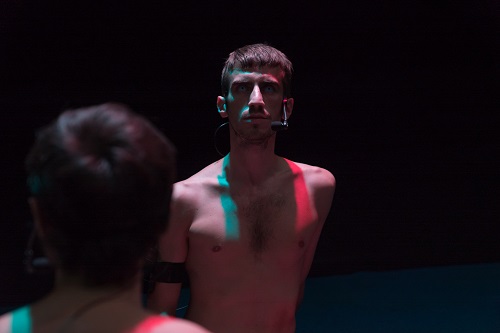 United Kingdom Jefta van Dinther’s Dark Field Analysis: Lilian Bayis Studio, Sadler’s Wells, London, 12.9.2018. (JO’D)
United Kingdom Jefta van Dinther’s Dark Field Analysis: Lilian Bayis Studio, Sadler’s Wells, London, 12.9.2018. (JO’D)

Choreography and Direction – Jefta van Dinther
Created with and performed by – Juan Pablo Cámara and Roger Sala Reyner
Lighting Design – Minna Tiikkainen
Scenography – Cristina Nyffeler
Sound Design – David Kiers
Dressed in nothing but their microphone earpieces and the shadows cast by overhead light, two men sit cross-legged on a square of bright green fabric in the middle of the Lilian Baylis Studio. The audience, looking very clothed by comparison, is arranged on all four sides. Even before it starts there is a powerful intimacy to the latest work that choreographer Jefta van Dinther brings to London.
Plateau Effect (2014) showed nine dancers of Cullberg Ballet straining at ropes and pulleys on the Sadler’s Wells main stage. As it Empties Out, at the Platform Theatre in 2015, had a cast of six. The hour-long Dark Field Analysis distils the choreographer’s apparent concerns with the body, perception and scenic space as if to present them in their purest form. If it looks at first like a ‘chamber’ work, lighting, sound and the choreographer’s sense of theatrical logic build to an unexpected and resounding climax.
The bodily concern is blood, though none is ever seen on the stage. The title, as a book of production notes that accompanies the piece explains, refers to ‘an alternative medical procedure using high-resolution dark field microscopy to observe live blood’. Blood is what the two men, in English that their accents slightly distort, in measured voices that the microphones make ‘disembodied’, begin to talk about. Their nudity, then, highlights skin as a penetrable boundary and container.
As the men speak, they move. One is lithe. The gestures of the other are robotic. He is not so much a naked human being as a naked machine. At first, their movements are on a small, even tentative scale. As the soundtrack (based on the work of PJ Harvey) increases in pace and volume, the men, always at floor-level, move more freely and with greater speed.
At the point when the soundtrack drowns out their words, both stage and auditorium go completely dark. Something similar happens in As it empties out. In that piece, too, the audience experiences a sensory bewilderment. When light returns after this darkness it is a half-light in which a ‘body made strange’ becomes gradually visible.
Under cover of the continuing pénombre the two men now crawl, scurry and scuttle about the stage. They drag each other across it. For a moment one of them resembles a figure from The Raft of the Medusa. A sexual element is there when they lie beside each other and arch their backs, or when one man crawls over the other; it can’t not be. But by now their nudity is almost a detail, or a detail that isn’t to do with sex.
After almost an hour of moving on their bottoms, hands and knees, the men slowly rise to a standing position and walk, robotically, around the stage. This marks the beginning of the end, the progression to a climax of which the audience palpably acknowledges the force.
John O’Dwyer